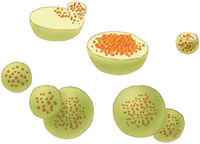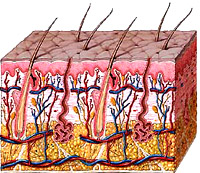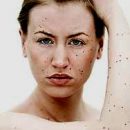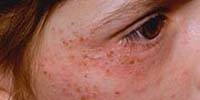What happens in the body in Hunter syndrome? Consider the usual life of the skin cells to understand where the failure of Hunter syndrome occurs.
Content
 In the human body there is a huge variety of biochemical reactions aimed at maintaining vital functions, such as the production of energy, growth and development, communication of individual organs and organism systems, protection against infections. Among vital functions there is such - the splitting of large biomolecules into the components and their withdrawal from the body. The failure of this particular function leads to a disease of the mucopolysaccharideosis of various types, including Hanter syndrome. The splitting of large biomolecules on small molecules occurs under the action of special substances - enzymes. Enzymes are formed in cells. Enzymes are necessarily present in all cells of the living organism. Accelerating biochemical reactions, enzymes direct and regulate the metabolism. All living cells contain a very large set of enzymes, whose activity depends on the functioning of cells. Almost each of the many diverse reactions occurring in the cell requires the participation of a specific enzyme. Enzymes destroying macromolecules are in special cell bags - lysosomes.
In the human body there is a huge variety of biochemical reactions aimed at maintaining vital functions, such as the production of energy, growth and development, communication of individual organs and organism systems, protection against infections. Among vital functions there is such - the splitting of large biomolecules into the components and their withdrawal from the body. The failure of this particular function leads to a disease of the mucopolysaccharideosis of various types, including Hanter syndrome. The splitting of large biomolecules on small molecules occurs under the action of special substances - enzymes. Enzymes are formed in cells. Enzymes are necessarily present in all cells of the living organism. Accelerating biochemical reactions, enzymes direct and regulate the metabolism. All living cells contain a very large set of enzymes, whose activity depends on the functioning of cells. Almost each of the many diverse reactions occurring in the cell requires the participation of a specific enzyme. Enzymes destroying macromolecules are in special cell bags - lysosomes.
Glycozaminclikans
Hunter syndrome biochemistry is associated with a problem in a portion of the connective tissue, and its intercellular substance. The composition of the intercellular substance includes fibers (collagen and elastic) and the main substance that prevails by volume. Fibers are located disordered, form a loose network.
The intercellular substance consists of a variety of sugars and proteins and helps to form a structure of a particular organ. The intercellular substance surrounds individual cells like a network and functions as glue that fastens individual cells. One of the components of the intercellular substance is complex molecules called proteoglycans. Like many components of the human body, proteoglycans from time to time should be destroyed and replaced with new. In the splitting of proteoglycans, mucopolysaccharides are formed, called otherwise glycozaminclikans (GG).
Mechanisms taking place in the skin
To better understand what glycosaminoglycans are, consider the mechanisms occurring in the skin. We all know that the human skin consists of three layers — epidermis, dermis and hypodermas.
 Derma plays the role of a frame that provides elasticity, strength and tensile skin. Derma can be safely compared with a certain unusual mattress: at the same time water and spring. In the mattress, the role of springs play collagen and elastin fibers, the entire space between which is filled with aqueous gel, consisting of mucopolysaccharides (glycosaminoglycans). By the way, the collagen molecules really resemble the springs, as the protein threads are crushed like spirals.
Derma plays the role of a frame that provides elasticity, strength and tensile skin. Derma can be safely compared with a certain unusual mattress: at the same time water and spring. In the mattress, the role of springs play collagen and elastin fibers, the entire space between which is filled with aqueous gel, consisting of mucopolysaccharides (glycosaminoglycans). By the way, the collagen molecules really resemble the springs, as the protein threads are crushed like spirals.
The elasticity and stability of the dermis on which «rest» epidermis are defined as a state «springs» — Collagen and Elastin fibers and the quality of the aqueous gel formed by glycosaminoglycans. If «mattress» Not okay — weakened «Springs», or gel does not hold moisture, — The skin begins to squeeze under the action of gravity, shifted and stretching during sleep, laughter and cry, wrinkle and lose elasticity. So form large folds, such as nasolabial.
In the young leather, collagen fibers and glycosaminoglycan gel are constantly updated. With age, the update of the extracellular substance of the dermis is slower, damaged fibers accumulate, and the number of glycosaminoglycans steadily decreases.
The main task of the cells of the dermis — Destroy and build (synthesize) intercellular substance (glycosaminoglycans). Mostly, these are engaged in cells - fibroblasts. Fibroblasts can be called both builders and architects that determine the composition and structure of the skin connective tissue. It is they first destroy collagen and hyaluronic acid, and destroying these molecules again synthesized. The process of destruction and recovery occurs continuously, and due to it the intercellular substance is constantly updated.
In aging leather, the activity of fibroblasts is reduced, and they are worse able to cope with their duties. Especially rapidly lost the ability to form an intercellular substance. But destructive abilities, to the great regret of women, remain at the same level for a long time. As they say, break — Do not build. In aging leather, collagen fibers become thicker, but their number and elasticity decrease. As a result, the structure of the collagen matrix is broken, the moisture content in the extracellular substance of the dermis decreases, and the skin, respectively, loses elasticity and elasticity.
The role of dermis and glycosaminoglycans
Derma plays the role of a frame that provides mechanical properties of the skin - its elasticity, strength and extensibility. It resembles a combination of a water and spring mattress, where the role of springs play collagen and elastin fibers, the entire space between which is filled with aqueous gel, consisting of mucopolysaccharides (glycosaminoglycans). Collagen molecules actually resemble springs, t. To. In them, protein threads are twisted like spirals. Glycosaminoglycans are large carbohydrate molecules that are not dissolved in water, and turn into a mesh whose cells capture a large amount of water - a viscous gel is formed.
Epidermis — This is the upper, constantly updated layer of skin. The special structure is connected with the delica — Basal membrane. It resembles a rug woven of protein fibers and impregnated with gel-like substance (glycosaminoglycans). Near the basal membrane, the derm contains more glycosaminoglycans, and her «Springs» Softy. This is the so-called puffy layer of the dermis. It forms a soft pillow directly under the epidermis. Under the nobble layer is a mesh layer in which collagen and elastin fibers form a rigid support grid. This mesh is also impregnated with glycosaminoglycans. The main glycosaminoglycan dermis is hyaluronic acid, which has the largest molecular weight and connects the most.
The state of the dermis, this mattress, on which the epidermis rests, its elasticity and resistance to mechanical loads is defined as a state «springs» - Collagen and Elastin fibers and the quality of the aqueous gel formed by glycosaminoglycans. If the mattress is not in order - the springs weaken, or the gel does not hold moisture - the skin begins to squeeze under the action of gravity, shift and stretch during sleep, laughter and cry, wrinkle and lose elasticity. In young leather and collagen fibers, and the glycosaminoglycane gel is constantly updated. With age, the update of the extracellular substance of the dermis is slower, damaged fibers accumulate, and the number of glycosaminoglycans steadily decreases.
Distribution in glycozaminglikanov tissues
Glycosaminglikanov has several types, each of which is formed in some characteristic places in the body. In turn, glycosaminglikans should also be split into smaller components that the body is able to bring out.
Glicosaminoglycans and their distribution in the tissues
Hyaluronic acid It is formed in the eye (vitreous body), joints (synovial liquid), leather, cartilage, bones
Chondroitin It is formed in the horn shell of the eyes, aorta, cartilage, skin, bones, scler
Chondroitin-4 sulfate It is formed in cartilage, skin, tendons
Chondroitin-6 sulfate It is formed in cartilage, skin, tendons
Heparin It is formed in the skin, lungs, liver, vessels
Heparsulfat Forms in the lungs, aorta
Keratan sulfate I Forms in the cornea
Keratannesulfate II Forms in cartilage
Dermatansulfat It is formed in the skin, tendons, sclera, cornea, cardiac valves
In the hunter syndrome, there is a problem when splitting two glycozamincline - dermatansulfate and heparasulfate. The first step during the splitting of these glycozaminclikins requires a special Lisosomal I2S enzyme (an enzyme located in a special bag in a cell - lysosome). In people with Hunter syndrome, this enzyme is produced or in insufficient quantities, or is not produced at all. As a result, glycosynclikans are deposited in cells throughout the body, especially in tissues that contain large quantities of dermatansulfate and heparasulfate. As a result of the accumulation of glycozaminclicks, internal organs and organism systems begin to work with failures, which leads to numerous serious defeats. Although the rate of accumulation of glycozamincline in people with Hunter Syndrome Nonodynakova, as a result, it still turns out to be widespread by a wide range of medical problems.









